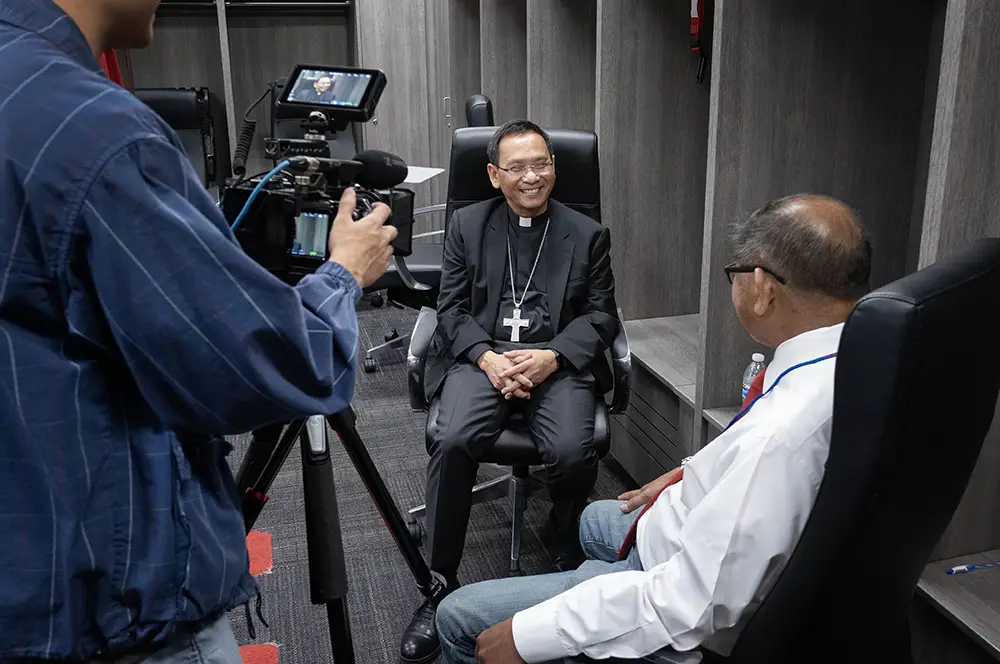Communications
Diocesan Statements, Media Relations and Contacts
Newsroom
The Administrator of the Diocese of San Diego, Bishop Michael Pham, issued the following statement today: With profound sadness and righteous indignation, we unite in prayer for the victims and
(SAN DIEGO) – His Holiness Pope Leo XIV has named Bishop Michael Pham as head of the Diocese of San Diego. He is the first Vietnamese American to lead an
The Administrator of the Diocese of San Diego, Bishop Michael Pham, issued the following statement today after Cardinal Robert F. Prevost was elected the new pope of the Catholic Church:
The Administrator of the Diocese of San Diego, Bishop Michael Pham, released the following statement on the passing of Pope Francis: “Pope Francis died today at 7:35 in the morning

Media Policy
The diocese welcomes members of the media to public events and asks only that they be respectful and remember that they are guests at a religious service. To arrange interviews or get broadcast permission for livestream video and similar resources, contact the Office of Communications at 858-490-8374. For after-hours assistance in English, call 858-490-8217. Para obtener asistencia en español, llame al 858-490-8374.
Communication Contacts
Aida Bustos
Director, Diocesan Media
Kevin C. Eckery
Director, External and Community Relations
Leonardo Enrique Fonseca
Manager, Social Media
Denis Grasska
Assistant Editor, The Southern Cross
Donna Lightsey
Advertising & Office Coordinator
Vanessa Villaseñor
Web Developer/Designer
Communication Contacts
Aida Bustos
Director, Diocesan Media
Editor, The Southern Cross
Kevin Eckery
Director, External and
Community Relations
About the Diocese of San Diego
The Roman Catholic Diocese of San Diego runs the length of California’s border with Mexico and serves more than 1.3 million Catholics in San Diego and Imperial counties. The diocese includes 96 parishes, 41 elementary schools, seven high schools and various social service organizations across the region. It also includes five historic sites, the most well-known of which is the Mission Basilica San Diego de Alcalá, the first mission established in California by St. Junipero Serra in 1769.
The diocese was established in 1936 and covered San Diego, Imperial, Riverside and San Bernardino counties. In 1978, the two northern counties were separated to form their own diocese, leaving the Diocese of San Diego to cover San Diego and Imperial counties.
Leadership
Bishop Michael Pham
Diocesan Administrator
Vicar General for Clergy
Auxiliary Bishop Ramón Bejarano
Vicar General for Ethnic and Intercultural Communities
Vicar General for Life, Peace and Justice
Vicar General for Ecumenical and Interreligious Affairs
Auxiliary Bishop Felipe Pulido
Vicar General for Parish Pastoral Initiatives
Maria Olivia Galván
Chancellor
Director of Pastoral Ministries
Demographics
Geographical Boundaries: San Diego and Imperial Counties
Square Miles: 8,852
Catholic Population: 1.3 million
Parishes: 96
Missions: 13
Elementary Schools: 41
High Schools: 7
Priests: 206
Deacons: 104
Religious Sisters: 146
Religious Brothers: 30
